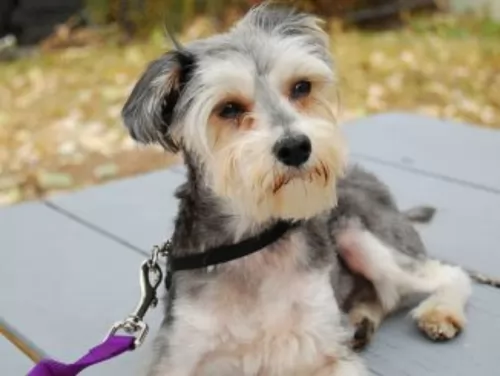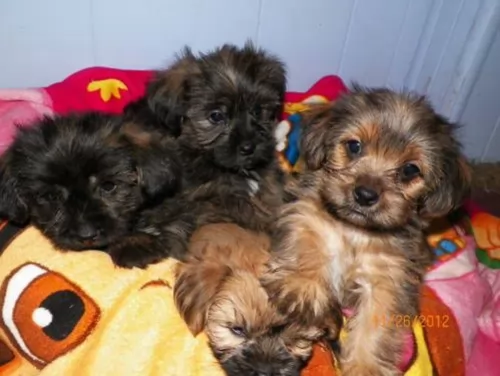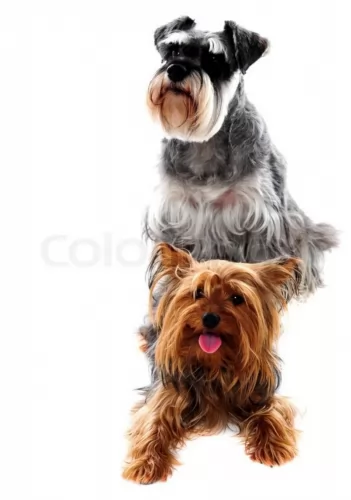 MyDogBreeds
MyDogBreedsSchnorkie is originated from United States but Moscow Guard dog is originated from Russia. Schnorkie may grow 38 cm / 14 inches shorter than Moscow Guard dog. Schnorkie may weigh 62 kg / 136 pounds lesser than Moscow Guard dog. Schnorkie may live 4 years more than Moscow Guard dog. Both Schnorkie and Moscow Guard dog has same litter size. Both Schnorkie and Moscow Guard dog requires Moderate maintenance.
 This dog is a cross between the Miniature Schnauzer and the Yorkshire Terrier.
This dog is a cross between the Miniature Schnauzer and the Yorkshire Terrier.
It’s not a purebred dog and is known as a designer dog. These dogs inherit characteristics from both of its purebred parents.
The origins and history of these breeds is often unknown with their being no records as to when or where breeders started developing them. This particular mixed breed dog originated in the United States.
Looking much like the Saint Bernard, the Moscow Guard Dog or Moscow Watchdog is large, descending from quite a few giant breeds such as the Saint Bernard, different Russian Hounds and the Caucasian Ovtcharka.
The dog has a gentle temperament. Known also as a gentle giant, the Moscow Guard Dog was developed in the Soviet Union and is fairly common in its native country.
The first US-born litter of Moscow Guard Dogs was born in 2015. The Moscow Watchdog hasn’t yet been recognized by the AKC.
 The Schnorkie is a small dog standing at between 12 to 30cm in height and weighing just 3 to 6kg.
The Schnorkie is a small dog standing at between 12 to 30cm in height and weighing just 3 to 6kg.
Schnorkies have an athletic build but they are lean and you want to keep them that way.
Their double coat is mostly silky and straight, but can be wavy too. The double coat can be grey, silver, fawnish and have a mix of colors while also being available in solid colors.
The ears are half erect, half floppy and the tail tends to be medium length, plumed and held up.
Schnorkies are high spirited little dogs and they can also prove to stubborn. There is nothing that a bit of training and socialization won't do for stubborn dogs, making them obedient and responsive to their owners.
Because they are hybrid dogs, they can inherit temperaments or looks from either of the parent dogs.
The Moscow Watchdog is a large mastiff-type dog. He stands at between 64 and 69cm in height ad weighs in the region of 45 – 68kg. He has a thick coat which is medium length, he has floppy ears and a long, plumed tail. The most common colors for the Moscow Watchdog are red and white with a little bit of black and tan around the head.
He is quite a heavy shedder so regular brushing and grooming is recommended.
He takes his role seriously as guardian and protector of his human family.
Large dogs don’t usually live as long as smaller breeds, and with good care your Moscow Watchdog can reach between 9 and 11 years of age. If you want your dog to be a parent, the litter size you can expect is anything from 5 to 10 puppies.
The dogs were used for guarding purposes and they are strong-willed, dominant and independent. They are also gentle dogs but will still require training and socialization to make them obedient and an all-round pleasant dog.
While the Moscow Watchdog is described as a pleasant dog, he isn’t a friendly teddy-bear kind of dog, tending to be fairly aloof. He would do well with an owner who is firm, fair, consistent and strong, as he is strong-willed.
 Your Schnorkie is a jaunty little dog who is going to love playing games with you. Children will need to treat him with gentleness and respect simply because he is small.
Your Schnorkie is a jaunty little dog who is going to love playing games with you. Children will need to treat him with gentleness and respect simply because he is small.
He is social, friendly and loving with his human family, though sometimes, coming from the Schnauzer, he gets a bit moody.
He makes a great family pet though and and while he loves to be outside playing, he also loves to come indoors and be everybody’s lap dog for the evening.
The Moscow Watchdog is a large dog and beautiful to look at. Even though he is large and strong, he is gentle and calm and makes a splendid pet.
Because of his large size he is better suited to life in the countryside or the suburbs as compared to smaller properties in the city. Their exercise needs will also need to be met such as a walk every day.
Think carefully before you take such a large dog into your home as he will require a lot of good food. Before investing in any dog, make sure that you have the means to provide him with an excellent home where he gets the best care, because he is willing to give you the very best of himself.
 Your Schnorkie, as a hybrid breed, can inherit some health problems from either parent – the Schnauzer or the Yorkshire Terrier.
Your Schnorkie, as a hybrid breed, can inherit some health problems from either parent – the Schnauzer or the Yorkshire Terrier.
Then again, mixing pure bred dogs can eliminate some common dog ailments. Overall, the Schnorkie is a healthy dog and can live up to 15 years of age.
A couple of major health concerns with the Schnorkie are dental problems and pancreatitis.
If your dog has tooth problems he might be in terrible pain and that is why it is so important to look inside his mouth.
Dogs can break their teeth and they can also get gum disease. Dogs have a more alkaline mouth and this is what encourages plaque. Try and brush your pet’s teeth with special canine toothpaste and toothbrush because dental disease can cause lots of problems for your pet.
The pancreas helps with the digestion of food and to regulate blood sugar. Pancreatitis is more common in Schnauzers, and then the pancreas is swollen and inflamed.
Dogs with this disease will lose their appetite, be lethargic, restless and have stomach pain. You may see your pet hunching his back. Pancreatitis can lead to organ damage and you will need to get your dog to the vet.
The Moscow Watchdog is a healthy dog breed, and with few inheritable health problems, you’re not likely to spend much at the vet with him.
Of course, any dog needs a good diet, adequate exercise, vaccinations, and parasite treatments to stay in top condition. Some of the common diseases to look out for -
We always have to mention hip dysplasia as it is so common with all dogs. Its an hereditary condition where lack of hip joint stability causes pain inflammation and lameness in the dog. Your dog, even though he is young, can develop hip dysplasia and then it can lead to early arthritis too. Your dog will need to get to the vet.
 Puppies will need 4 small meals a day, but by 8 weeks your Schnorkie will be ready to move onto dry dog food. As he grows into an adult you will cut the meals down to two a day.
Puppies will need 4 small meals a day, but by 8 weeks your Schnorkie will be ready to move onto dry dog food. As he grows into an adult you will cut the meals down to two a day.
The best commercially manufactured dry dog food is able to meet your dogs nutritional needs and it’s super convenient too. It can be a good idea to feed your pet some home-made food too. Twice a week will be sufficient to add in this home-made food - boiled chicken, brown rice or pasta, sweet potatoes, carrots and spinach will be excellent for him and his digestion and be a tasty treat for him. You can simply chop it up and add it to the dry kibble. Some raw meat occasionally can help to ward off nasty skin ailments. Make sure that your Schnorkie has a constant supply of cool fresh water.
Schnauzers and Yorkies both have high maintenance coats and your Schnorkie will also require regular brushing, though he doesn’t shed much. Some people prefer to hand their dogs in and have them professionally groomed.
Just because a Schnorkie is a little dog, doesn’t mean he doesn’t need exercise. You don’t want a small dog like this getting obese and unfit. Take him for walks and give him some ball games.
This is a large breed dog so you want to make sure that if you feed him from the many commercially manufactured foods there are, it is the high quality one packed with vitamins and minerals and which cater specifically for large breeds to ensure the right amount of minerals and vitamins for his size.
You don’t want to just go on and on giving him dry kibble every day, so occasionally it will be a good idea to give him some boiled chicken, brown rice or pasta and some cooked vegetables which can be added into his kibble. This is all the variety your dog needs, as dogs like consistency and simplicity because then they don’t suffer with digestive issues.
Never leave him without a constant source of cool, fresh water.
Contrary to what this dog looks like – large and clumsy, he is actually quite agile and will require a good amount of exercise. He may not look particularly active but he will certainly want a daily walk and he will also require running off the leash in the park or some ball and rope games in the garden.
he Moscow Watchdog has a thick, medium length coat. He doesn’t require professional grooming, but a good brush through once a week will help to condition the coat. Also, the breed is a moderate shedder so removing loose hair keeps the coat shiny and healthy.